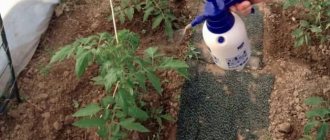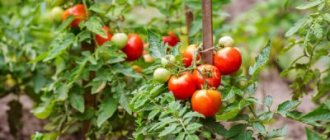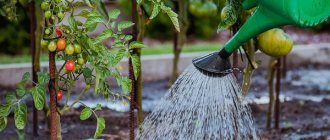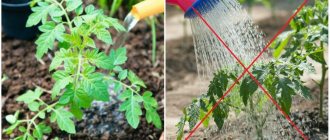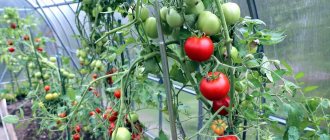Vegetable growing » Tomatoes
0
2447
Article rating
Kira Stoletova
Tomatoes prefer fertile soil and constantly need feeding. In order not to harm the plantings, the gardener needs to know which fertilizers can be used for tomatoes in open ground and which cannot. With proper nutrition of tomatoes, you can expect a good and tasty harvest.
Useful fertilizers for tomatoes in open ground
How to feed tomatoes if you bought bad seedlings
Unfortunately, it is not always possible to purchase or grow strong tomato seedlings. Sometimes, due to lack of light, its stems become elongated, grow slowly, and the leaves wither. But don’t get upset and write off such plants: they can still be “revived”!
To do this, feed the picked seedlings with a complex mineral fertilizer, such as azofoska (1 tbsp per 10 liters of water), and microelements. Growth stimulants (Epin, Ecosil) will also help the seedlings to become stronger. They are used (in accordance with the instructions) 1-2 days before planting tomatoes in the ground.
Why do you need to fertilize tomatoes after planting in open ground?
Plants develop poorly, may get sick or suffer from an invasion of parasites when there is a lack of microelements, so they actively take from the soil everything that was put into it by nature and introduced by the gardener.
Nutrient deficiencies affect the appearance, taste and quality of tomatoes. Vegetables need:
- nitrogen - it helps seedlings grow leaves;
- phosphorus - guarantees strength and ensures uniform cellular metabolism. Without it, nitrogen absorption deteriorates;
- potassium - helps move carbohydrates from leaves to fruits;
- sulfur - stabilizes protein synthesis.
How and what to feed tomatoes during flowering
At the beginning of the blooming of the second flower cluster, dilute 0.5 liters of chicken manure in 10 liters of water, add 1 tbsp. superphosphate and 1 tsp. potassium sulfate. Stir the resulting solution well and pour it over the tomatoes, using 1 liter for each bush.
The following feeding options have also proven themselves to be quite good:
- 1 tbsp. Agricola Vegeta, 1 tbsp. superphosphate, 1 tsp. Potassium sulfate or potassium chloride is diluted in 10 liters of water.
- 1 tbsp. Signor Tomato fertilizers are dissolved in 10 liters of water.
When the third flower cluster is blooming, dilute 1 tbsp in 10 liters of water. liquid potassium humate (it can be replaced with sodium humate or Ideal fertilizer - in the same dosage) and nitrophoska. The fertilizer consumption rate is 5 liters per sq.m.
Fertilizing tomatoes in autumn
In the fall, soil preparation begins for spring planting of tomatoes. During this period, phosphorus fertilizers, potassium chlorine-containing compounds, and manure are used.
Nitrogen fertilizers are applied in small quantities and only in ammonia forms. Mainly practiced on hard clay soils.
Video on how to get a high yield of tomatoes using the right fertilizers
Potassium sulfate can be added to the soil in the fall. Especially on sandy lands.
The amount and type of fertilizers are used depending on the type of soil and the rate of distribution of nutrients.
In the fall, you can start laying a “compost barrel” - unused fruits, vegetables, manure, grass. Leave it for the winter and fertilize the soil with the prepared mixture in the spring.
What is the best way to feed tomatoes during fruiting?
When the fruits set, feed the tomatoes with 1 tbsp. superphosphate, dissolving it in 10 liters of water. For 1 sq.m of tomato bed, use 10 liters of solution.
To form a large number of tasty and fleshy fruits, plants need elements such as boron, manganese, iodine and potassium. You can compensate for their deficiency by fertilizing with a complete mineral fertilizer with microelements or by preparing a nutritious fertilizer yourself. To do this, dissolve 10 g of boric acid powder, 10 ml of iodine in 10 liters of water and add 1.5 liters of sifted ash. Mix everything well and pour 1 liter of the composition under each bush, after watering the plants well.
Remember, boric acid does not dissolve in cold water. It needs to be filled with a small amount of boiling water and then pour the resulting solution into a bucket of water.
Choosing the appropriate method for applying different fertilizers
You can help plantings using one of several methods. Fertilizer for tomatoes in open ground is applied before sowing, then during sowing and planting, and during the growing season.
Before the growing season, the soil is fertilized for digging with the entire prescribed dose of phosphorus and potassium and about 30–50% of the dose of nitrogen. Potassium and phosphorus preparations are applied after a chemical analysis of the soil. Potassium is used in sulfate form (tomatoes do not like chlorine, and therefore potassium salt). Multicomponent NPK formulations with a distribution of substances of 18:6:20 together with microelements work well.
Nitrogen is used as a fertilizer for tomatoes in open ground during the growth stage, but calcium and other microelements are often required. Methods of applying fertilizer: spreading between rows or spraying. Before the growing season, root feeding is more effective. Foliar ones are not the main, but additional nutrition. They are effective when the bush cannot obtain sufficient nutrition from the roots, as well as when a deficiency of one element is detected.
Foliar fertilizers cannot be combined with herbicides, and the use simultaneously with insecticides and fungicides must be approved in the instructions.
How to feed tomatoes after cold weather
In the unstable climate of the middle zone, night frosts and sudden temperature changes are frequent “guests”. Tomatoes grown in unprotected soil can suffer greatly from them.
To “reanimate” plants, their leaves and stems need to be sprayed with Epin Extra in the morning or evening. This drug increases the immunity of tomatoes and stimulates their natural physiological processes. It is recommended to repeat spraying with Epin every 7-10 days until the tomatoes are completely restored.
If Epin Extra is not at hand, you can try to save the tomatoes using the drug Zircon.
Also, damaged plants need additional nutrition. Under each bush you need to pour a small handful of crystalline urea, and after 7-10 days add a solution of chicken manure to the soil.
To prepare it, fill a barrel or other fairly capacious container with bird droppings halfway, then fill it to the brim with water and let it brew for 3 days. After this period, dilute the concentrate with water in a ratio of 1:15. Then feed the tomatoes at the rate of 3 liters of solution for each bush.
Selecting soil and preparing it for planting tomatoes
It has already been said above that tomatoes came from South America. They have a lot in common with potatoes, including diseases. Therefore, it is not recommended to plant tomatoes in the place where potatoes previously grew. Pathogenic microorganisms may remain in the soil, which will prevent young seedlings from gaining strength.
Tomatoes should have a separate place in the garden bed. The soil for tomatoes needs to be prepared in the fall. Apply phosphate fertilizers, since they take the longest to dissolve and react with the soil; organic fertilizers - manure or compost are also applied in the fall. By spring, the manure will decompose and will be suitable for plants to absorb.
In autumn, fertilizing is applied to a depth of about 30 cm and dug up, leaving large clods of earth. This promotes better hydration when the snow begins to melt in the spring.
The seedlings are planted in separate holes 10–15 cm deep at a distance of 50 cm from each other. Depending on the plant variety, the distance may be less – up to 30 cm.
You can also make a continuous hole - a trench. This is necessary so that water and liquid fertilizers do not spread, but fall directly under the root of the plant.
How to feed tomatoes with boric acid to protect them from late blight
To prevent late blight and other fungal diseases, treat tomatoes using folk remedies - potassium permanganate, boric acid and iodine. As soon as the ovary begins to form, spray the plants with a weak (pink) solution of potassium permanganate. Then, after a week, treat the tomatoes with boric acid (1 tsp per 10 liters of water). And a week later - with an iodine solution (1 teaspoon per 10 liters of water).
You can also use ash infusion, prepared at the rate of 2 tbsp, against late blight on tomatoes. wood ash per 1 liter of water and aged for 2 days.
Organic fertilizers for tomatoes
For tomatoes, organic matter popular among gardeners is quite suitable: humus, peat, compost. The application of organic fertilizers at the first stage of development is especially valuable, since these compounds are rich in nitrogen. In the future, organic fertilizers are used in combination with mineral fertilizers containing potassium and phosphorus.
The principle “the more the better” does not work with organics. An excess of such nitrogen-containing nutrition leads to excessive growth of green mass. The tomato will go into the tops to the detriment of flowering and yield. Therefore, I advise you to use natural fertilizers in strict dosages.
horse and chicken manure in granules as fertilizer
Cow dung
Mullein is the most common organic fertilizer. The most popular fertilizer for tomatoes based on it:
- I fill a bucket of manure with 4 buckets of water.
- I transfer it to a warm place, without covering it with a lid, and let the mixture brew for several days.
- Dilute the concentrate with water 1:4.
- I apply fertilizer before the tomatoes begin to bloom profusely. For one bush there is as much fertilizer as you release water when watering. Do not allow drops of fertilizer to get on the tops - be sure to wash them off with water.
After abundant color formation, use manure in combination with mineral compounds and microelements:
- For a bucket of water - 1 glass of mullein, 1 glass of chicken droppings.
- I insist on the composition for a day.
- I add 1 teaspoon of potassium sulfate, 7 g of boric acid.
- I dilute it with water 1:2 and use it for its intended purpose.
I will present other similar instructions for preparing complex fertilizers based on mullein:
- Dilute the pre-liquefied manure with water 1:10. For each bucket of solution - 1 liter of ash. Mix the ingredients without covering, leave to infuse in a warm place for 2-3 days. After this, use the mixture for its intended purpose.
- Mix 1 liter of liquefied mullein with 10 g of nitrophoska in a 5-liter bucket. Then add water to the brim and stir again. Then do not forget to dilute the concentrate with water 1:1.
- For 10 liters of water - 1 liter of liquefied mullein, 6 g of boric acid, 10 g of potassium sulfate.
Chicken droppings
Chicken manure is also replaced by other poultry manure, but this particular manure is known for its higher concentration of nitrogen. Therefore, it is strictly forbidden to use such fertilizer in fresh, undiluted form! The same rule applies to the droppings of geese, ducks, and turkeys.
I first make an infusion: pour 1 kg of litter with a bucket of water. I leave the mixture for several days, after which I dilute it again with clean water until the liquid takes on the color of tea.
A nutrient solution from bird droppings in its pure form is used before the stage of ovary formation. Then complex compositions with mineral components are shown:
- For a bucket of water - 0.5 kg of bird droppings.
- To the resulting solution - 5 g of potassium sulfate, 20 g of superphosphate.
Compost
Do not forget about such an effective natural fertilizer as compost. It is harmless, useful, reliable and completely free - made from waste. The readiness of compost depends on its components: grass, branches, leaves are processed into compost over a period of 2-3 years. But the process can be significantly speeded up by adding the following:
- coffee grounds;
- tea leaves;
- fruit, root, vegetable peelings;
- straw, hay;
- cereals;
- wood shavings and sawdust;
- ash;
- paper.
filling the compost pit
I also know a method for preparing “quick compost”:
- For a 5-liter bucket - ½ cup lime, ½ cup ash, 1 tbsp. spoon of urea.
- Fill the remaining space with water to the brim of the bucket.
- Take it to a warm, dark place and leave for 3-4 days.
- Strain the mixture without diluting with water, use it for root fertilizer.
Peat
A considerable part of gardeners find that peat is healthier than humus. Its use is also much more economical - 2-3 times less fertilizing is required. Peat not only fertilizes, but also improves the structure of the soil - it makes the substrate more breathable, soft, loose and light.
The simplest use is to add dry peat in the fall or early spring. The fertilizer is evenly distributed over the ridge and incorporated into the substrate when digging. For 1 m2 - 1-2 kg of peat.
But be careful: fertilizer cannot be used in its pure form when developing tomatoes. The solution here is to use peat as a compost component. I present the instructions:
- Place peat at the bottom of the pile in a 30-centimeter layer.
- Then - a 10 cm layer of sawdust.
- The next 20 cm layer is grass, weeds, straw, food scraps mixed with garden soil.
- Then a layer of mullein or chicken droppings.
- This entire “sandwich” is covered by another 30-centimeter layer of peat.
- Cover the sides of the pile with the same peat or garden soil.
- Periodically water the compost with a superphosphate solution (100 g of the drug per 1 bucket of water).
- Turn the pile monthly throughout the summer.
- Expect the compost to be ready in 1-1.5 years.
Other organic fertilizers
I will present to you other natural fertilizers that are useful for our tomatoes:
- Baker's yeast. For 1 liter of water heated to 37-40°C - 200 g of fresh pressed product. I wait for the mass to ferment for 10-15 minutes, after which I dilute the concentrate with another 5-6 liters of water. To speed up fermentation, add 1 tbsp. a spoonful of jam, sweet syrup or sugar. In order to get the maximum benefit from yeast feeding, I apply it only to heated soil - in the evening of a hot sunny day. I use it no more than 3 times during the growing season.
- Coffee grounds. This is a source of mostly nitrogen, and a lesser source of phosphorus, magnesium and useful microelements. The easiest way: I sprinkle dried, washed coffee near the trunks of the tomatoes, then cover them with a thin layer of soil and organize watering. You can also prepare a complex fertilizer: combine grounds, last year’s leaves, and dry straw in a ratio of 2:1:1. Stir, put in a pile without covering it with polyethylene - after 3 weeks you will receive ready-made nutritious compost.
- Herbal infusion. The best base for green fertilizer is nettle. It is replaced with dandelion, chamomile, woodlice, quinoa, after removing the roots, flowers and seed pods. I finely chop young nettles, pour them into a tank, and fill them with water. I leave it to ferment for 10-14 days, after which I strain it. Then I dilute the concentrate with water until the liquid turns light brown. To make the infusion more nutritious, you can add phosphorus, potassium, ash or manure to it in a small amount.
coffee grounds for tomatoes
Why do you need foliar feeding of tomatoes?
When fruit ovaries appear, spraying is stopped.
Foliar feeding (spraying on the leaves) of tomatoes helps speed up the setting and ripening of fruits. It is carried out during the flowering of plants.
At the beginning of flowering clusters, spray the tomatoes with a 0.5% superphosphate extract. To prepare the extract, pour 50 g of superphosphate into 10 liters of hot water and stir several times. Let the solution brew for 24 hours, strain before use and use 10 ml of fertilizer for each young plant, and as the bushes grow, increase the dose by 1.5 times.
In addition, this foliar feeding is useful: dilute 1 tbsp in 10 liters of water. urea or fertilizer Ideal and treat the leaves with the resulting solution.
How to save tomatoes if the weather is bad?
In damp and cloudy summers, when tomatoes do not have enough light, and due to high humidity there is a high risk of fungal diseases, you can treat the tomatoes with a growth stimulant (for example, Epin) on the leaves:
- the first time - when at least half of the flowers in the inflorescence open,
- the second - at full flowering.
It is recommended to do this in sunless weather or in the morning or evening (before 10 and after 19 hours).
To prevent fungal diseases of tomatoes in the second half of summer, it is useful to additionally apply phosphorus-potassium fertilizer.
How to water tomatoes in a greenhouse
Greenhouse tomatoes are watered frequently and evenly. If the soil has dried out, then excessive watering can cause cracking of the fruits, so do not “flood” your greenhouse if you accidentally overdry it: it is better to water it several times, little by little.
Before fruit sets on the first cluster, moderate watering is recommended, but without drying out the top layer of soil. When the mass filling of fruits begins, the norm is increased. Plant stunting and loss of flowers may be signs of lack of moisture.
